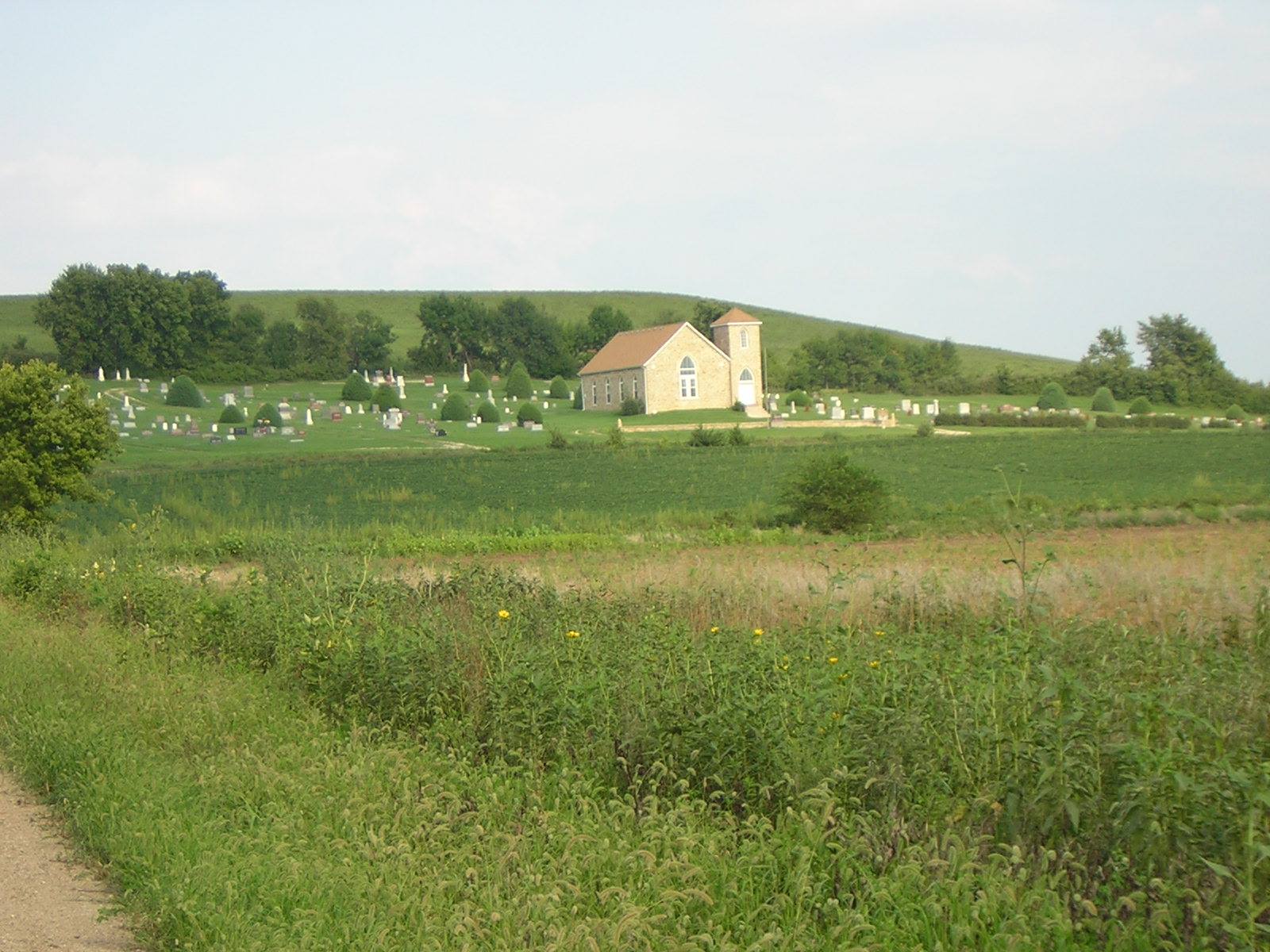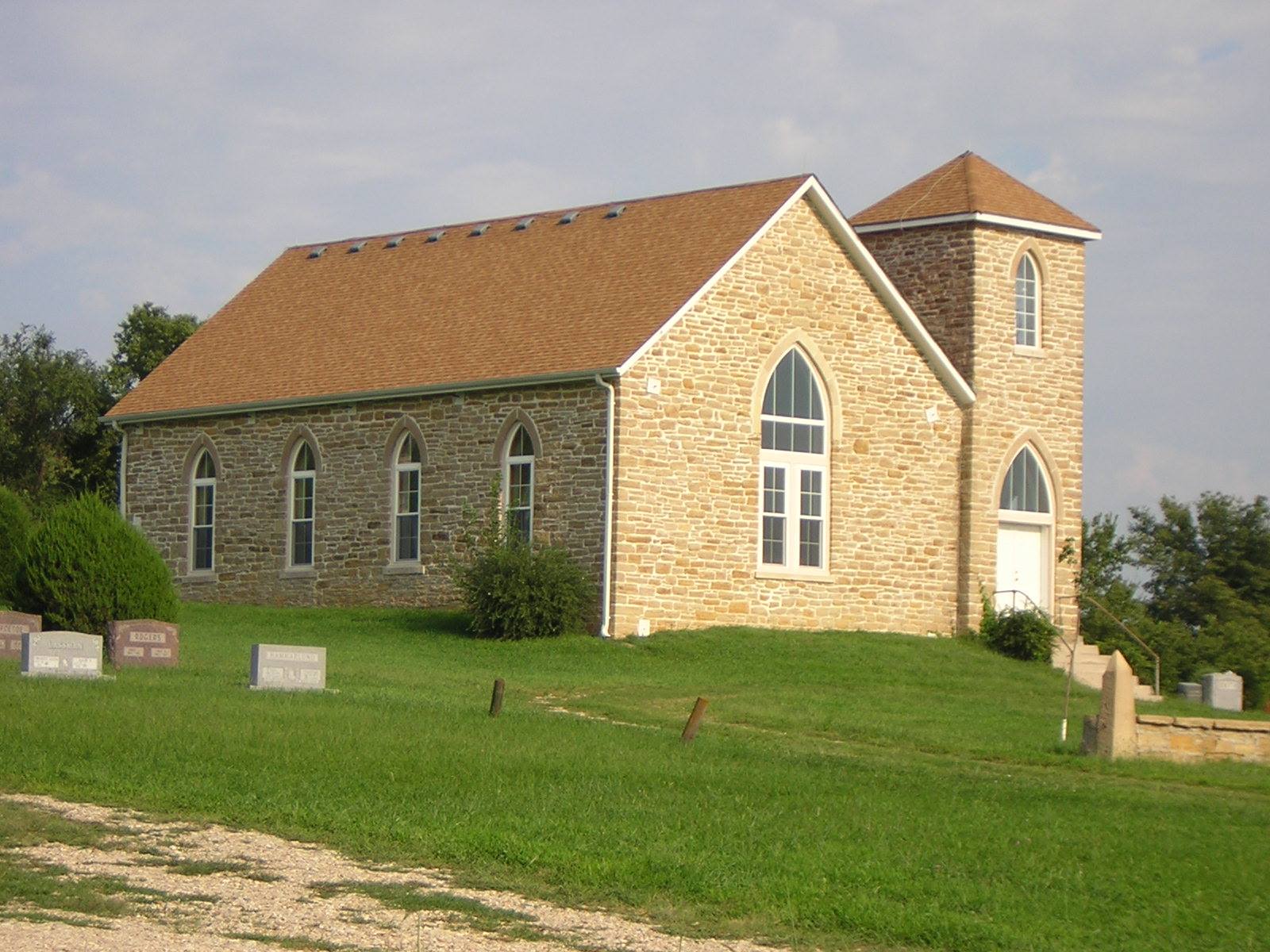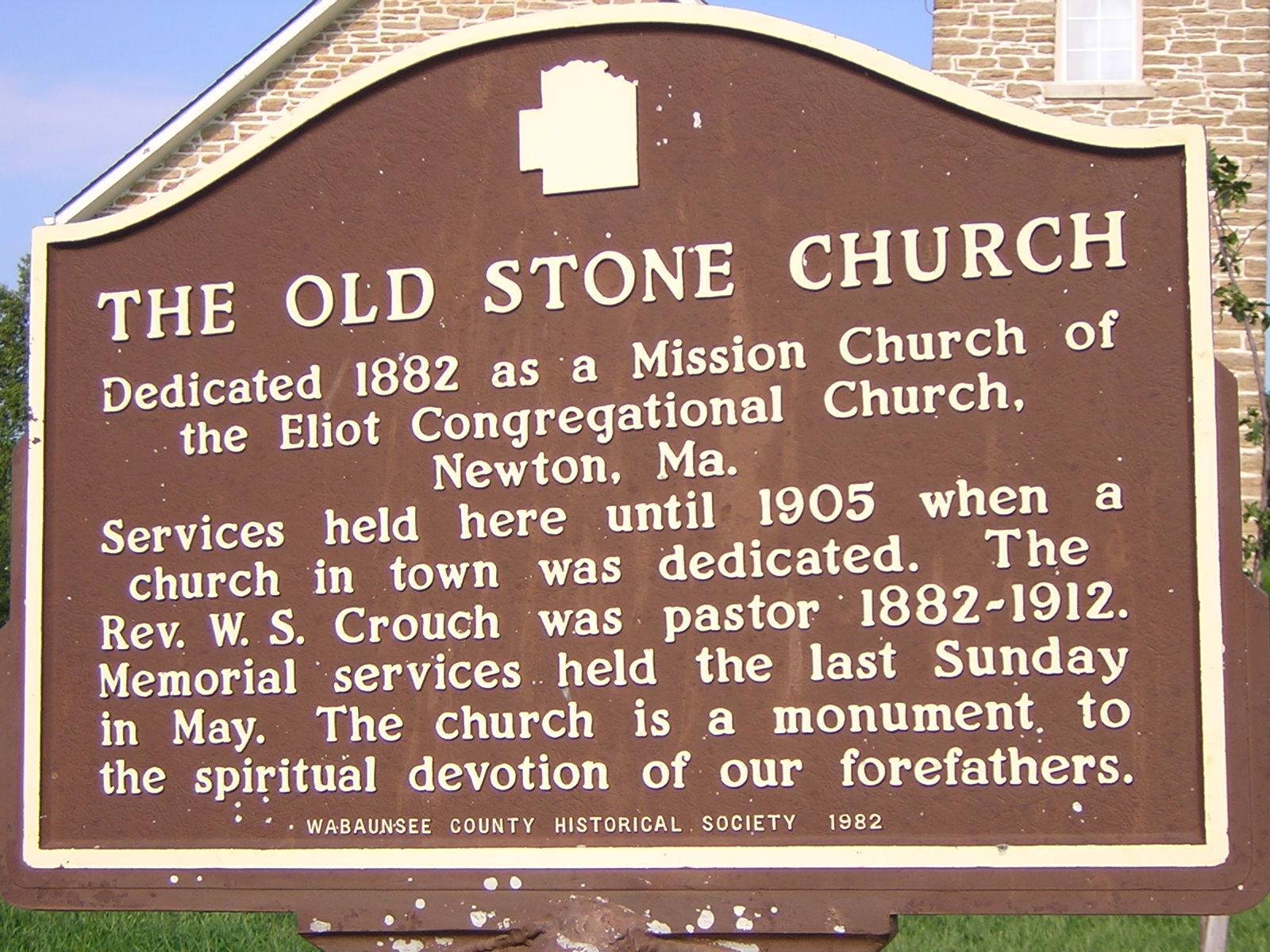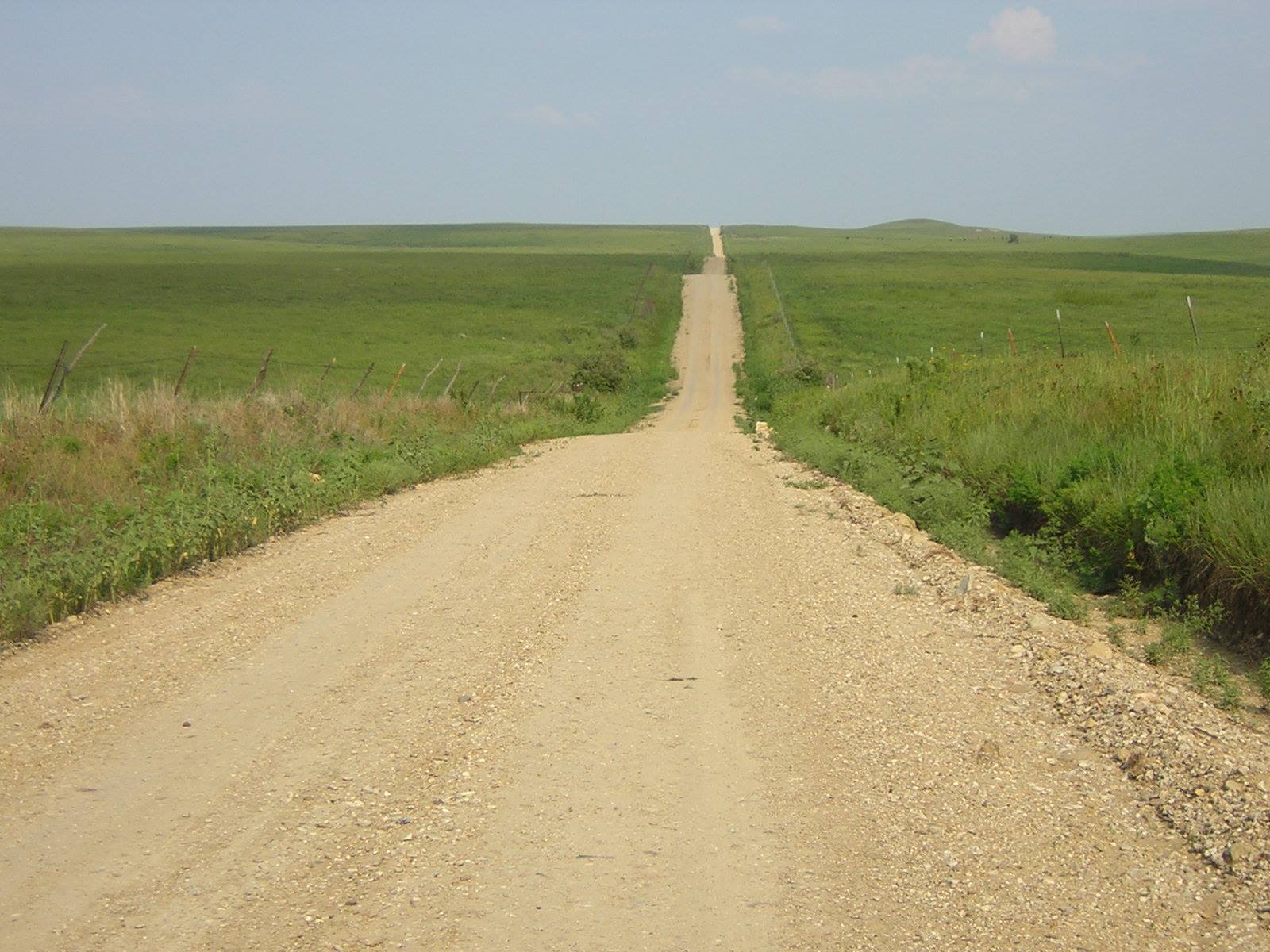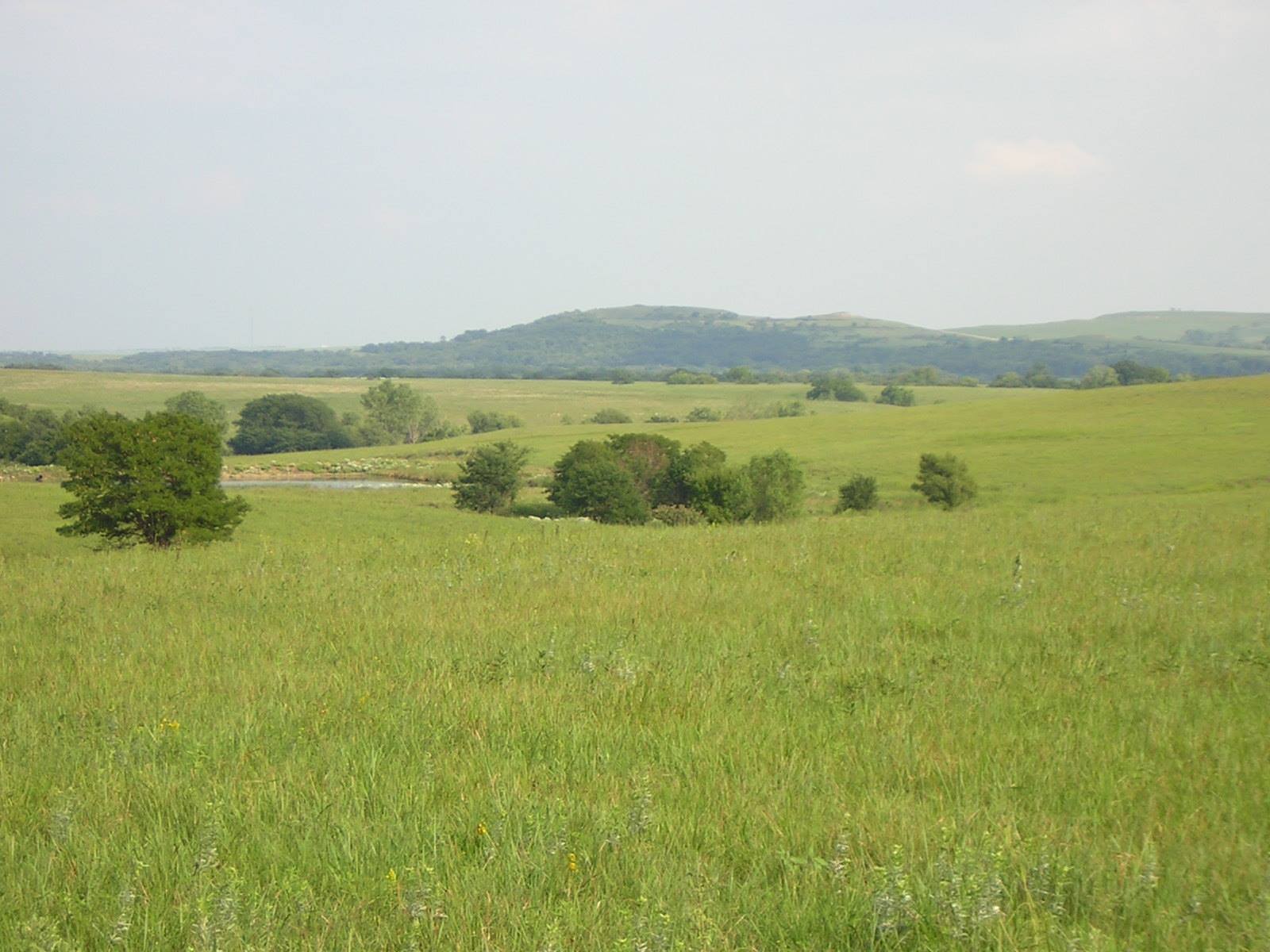I always get very upset with myself when I don’t attend Memorial Day Services at the Old Stone Church. What a wonderful collection of memories I have surrounding all the years I have been able to attend. I wrote a story story about my experiences a few years ago and I’ll share it with you now.
Decoration Day Fifty Years Ago
By: Nick Clark May 24, 2003
As I awoke this morning to find bright sunlight streaming through my window, I couldnt help thinking that had it been fifty years ago, my mother would have been tugging at my toe and urging me to, Get up. We need to get the jars in the car, pick flowers and get going to the cemeteries. The next day, Sunday, would be Decoration Day, and we werent the only ones hurrying aroundnearly every household in Maple Hill and the surrounding countryside would be doing the same thing.
By the time breakfast was over, my grandmother, Mildred McCauley Corbin would be in our kitchen, as well as my Aunt Bonnie Mitchell and at different times, others of our family and neighbors. My paternal grandmother, Central Mable Clark, was always running the telephone switchboard located in her home so she would send jars the night before to take to the cemeteries where her relatives were buried.
It was an important day for the entire community. It was a day to remember and honor the lives of all ancestors, but especially those who had served in the Armed Forces. Decoration Day began on May 5, 1868 when the Grand Army of the Republic (an organization honoring those who served in the Union Army) held a ceremony at Arlington National Cemetery. Mrs. Ulysses S. Grant, wife of the President, gave a stirring address lauding the deeds of brave soldiers who had served in blue during the war between the states. After the speech making had been completed, orphans of soldiers and sailors paraded into the cemetery with baskets of flowers, strewing them on the more than 20,000 newly occupied graves. As years passed the ceremony was echoed through the entire country and became a part of the fabric of our nations ceremonial history.
As America engaged in other wars over time, the occasion took on significance and also changed names. After World War I, the observance became known as Memorial Day and in 1971, Congress at the urging of President Lyndon Johnson, made Memorial Day an official holiday to honor those who served in Americas Armed Forces. Although I had certainly heard or read the term Memorial Day, I dont remember my family calling it anything other than Decoration Day until I was grown.
Activity in the household would increase on those Saturday mornings, as we loaded jars into the trunk of my grandmother Corbins car (as I recall a 1953 Ford). We would take big gallon jars of water along and in later years, rolls of foil to wrap around the jars. Then we would proceed to the home gardens of various family members and pick fresh flowers to put in the jars placed on graves. My great grandmother, Jeanetta Reinhardt Jones, always had beautiful big boughs of spirea. The little white crowns of flowers were striking in bouquets. We would then proceed to my Aunt Bonnie Mitchells home and pick up the bucket or two of multi-colored iris that she had picked earlier. My Grandmother Clark would have supplied Iris of various colors from the Central Office garden. She also had big tall spikes of larkspur in pink, purple and blue. Grandmother Corbin had a beautiful climbing red rose, a Mary Perkins, which bloomed early and was beautiful to include as a highlight in bouquets. All these ladies furnished varieties of colored peonies. When finished, the car would look like one following a hearse to a funeral. We would then set off to the cemeteries where various relatives were buried.
We often went to the Uniontown/Greene Cemetery southeast of Willard, Kansas first. In that cemetery are buried my paternal great great grandfather Francis Marion Jones, and my great grandmother Virgia Miller Jones, and my great uncle Louis Jones. They were the grandfather, mother and brother of Mable Clark. The cemetery was small and was usually well kept by the Greene and Viergiver Families, who lived nearby. But as they aged, the cemetery fell into an unkempt condition and it was always tricky getting into the graves without the fear of SNAKES! Great great grandfather had served in the Civil War, had a Civil War headstone and also a GAR marker. It was important that we decorate his grave. Always mixed in with the placing of flowers was the telling of family stories and talk of their military service. It was a great time to be 10-years-old and hear those accumulated memoriesa real treasure.
Then we would usually go back to Maple Hill via gravel road, trying our best not to upset the buckets of flowers or slosh water into the trunk and back seatwhere I was crowded between giant sprays of iris, peonies and larkspur. Our destination was the Old Stone Church Cemetery west of Maple Hill.
There we drove up and down the avenues of eastern red cedar trees, stopping at the graves of the Clark, Corbin, Mitchell, Lemon, Jones, and McCauley Families as well as at the graves of others who might not have family members living nearby. It was always a courtesy of many families to decorate the graves of dear friends or long-gone families. The James Elmer Romick American Legion Post members would be visiting the graves of veterans and placing little metal American Legion plaques on the graves of soldiers. In each plaque was placed a tiny America Flag.
In the evening, we would usually go to Bethlehem Cemetery, south of Paxico, where we would place flowers on the graves of Clark relatives. Sometimes, not always, we would go to the Vera Community and stop at the graves of Albert and Martha Graham Phillips, who were buried in the pasture across the road from the home of Merle and Nora Lietz. They were the parents of my cousin, Mable Phillips Herron (Mrs. Jack). They were struck by lightening and killed in their carriage in the 1870s. The horses were not injured and carried their bodies home. The telling of that morbid but fascinating story would then occupy the return trip to Maple Hill.
In my high school years (1958-1962,) the Maple Hill Community Congregational Church had a very active youth group composed of junior and senior high
young folks. Although I dont recall the exact numbers, I would estimate that there were 20 to 30 in regular attendance. During my memory, the Pilgrim Fellowship Group was led and supervised by Jack and Bill Warrensons of William Warren, a charter member of MHCCC. The Warren brothers lived on a farm three miles west of Maple Hill and would usually bring their farm truck into town and meet PFG members at the newly constructed Parish Hall. We would load folding chairs, a huge upright piano, hymnals, the big original bible, lectern stands and sometimes we would take the old original chairs from the church alter. Warner Adams and other men were always on hand to help. This moving was necessary because most of the original Stone Church furnishings had been destroyed in a tragic fire on May 12, 1952.
Although only seven at the time, I remember the Stone Church fire because it was one of those major community events that is vividly recalled to the minds of most of those who witnessed it. Ivan Yount and Walter Punt Romick were trimming cedar trees at the cemetery and had piled a stack of sheared limbs at the north side of the cemetery property, a good 300 yards from the building. Limbs had been burned before in the same way and the distance was presumed to be safe. Nothing burns with more vigor than red cedar and when the pile was lighted there were only light winds from the south. Suddenly gusts of wind began, the direction changed to the north and the sparks were carried to the wooden shingles of the church before anything could be done to prevent it.
I was just completing the second grade at Maple Hill Grade School and was spending a pleasant spring day at my Grandmother Corbins farm home located one and one-half miles southwest of Maple Hill. We were planting beans in the garden. All of a sudden, we heard the old wall telephone in the kitchen begin to continuously ring in short bursts. That was a sign to immediately pick up on the eight-party line, because there was something of dire importance that needed the attention of the entire community. Grandmother hurried to the house where the voice on the phone was that of my other grandmother, Mable Clark at the Central Office. She was notifying the community that help was needed at the church fire. Punt Romick and Ivan Yount had driven one-quarter mile to the Romick home, and had phoned in the alarm.
Grandfather Corbin had taken the car at the time, and we had no way to go to the fire, but we could clearly see the cemetery from the farm and could also see the column of black smoke rising high into the sky. My grandmother just sat down on the back steps and buried her head in her big apron and wept. Pretty soon, we heard someone calling to us from the road and it was Mrs. Ella Yount, Ivans mother, who had walked the quarter mile to my grandmothers. They both sat on the steps and wept in each others arms while I looked onstunned. The decades-old shingles were consumed within minutes and it was only through heroic efforts that the original pump organ, pulpit and a few other treasures were saved.
The Old Stone Church Cemetery Board had raised enough money immediately following the fire to replace the roof, floor, windows and front doors. Topeka architect, Charles Marshall, cousin of Mrs. Warner Adams, donated his time to plan the restoration. Services were held in the buildings shell until 1962, when some of Maple Hills older citizens joined forces with the Pilgrim Youth Group to raise funds for the restoration of the Old Stone Church interior. Emily Adams made long lists of local and distant people whose relatives had attended the Old Stone Church. From January through May, I went to the Adams home and typed letters on an old portable Royal typewriter. Miss Adams furnished the stationary, envelopes and stamps. The response was overwhelmingly favorable. My only regret, is that the letters that accompanied donor checks were not saved as they were a tribute to the love of the Old Stone Church, held so dearly by early church and community pioneers.
Although the outer structure of the church had been replaced, the interior plaster had never been removed from the walls and that would require tedious labor. At the urging of Jack and Bill Warren, the PFG decided to spend weekends taking the old plaster off the walls. Scaffolding was placed inside and we all brought our claw hammers and worked long hours removing plaster which had been applied directly to the stone walls. We would go home in the evening with hair stiff from plaster dust. Our mothers brought lunch to the church and we had grand times playing games and exploring the cemetery. I am going to be sorry that I ever tried to list names, and my apologies to those I have omitted because of memory loss, but I recall the following helping with plaster removal: Mary Sue Kitt, Janice Yount, Patty Holmes, Norris and Horace Hoobler, Art and Kathryn Adams, Rod and Cathy Say, Eugene and Karen Travis, Tracy and Larry Ables, Larry and Lana Schulte, Mike Turnbull, Bill, Art and Ruth Ann Raine, Linda and Terry Ungeheuer, Allen and Loren Lett, Trudi and Marcia Mee, Claudia and Kenny Arnold, Larry and Cheryl Oliver, Eula and Beulah Adams, Dean and Jean Adams, and Ronnie and Herb Crawshaw.
Ronnell Bennett, a Black plasterer from Alma, Kansas was employed to put on three good coats of plaster. Mr. Bennett had learned his trade from pioneer German plasterers and had an excellent reputation. The workmanship was superb and his work remains in good condition today. I dont remember the exact cost of the total restoration, but I do remember that Miss Adams and I were delighted when the bank account approached $4,000.00. Special thanks is owned to Ann Gorbet Adams and her father, John Gorbet, who provided expertise in choosing colors of stain for the floor and paint for the wall. In addition, the Hammarlund Family donated a beautiful cross for the front of the sanctuary that was made from the historic timbers of the St. Marys Congregational Church, St. Marys, Kansas.
After the plastering was completed, there was about $300 or $400 left in the account. Miss Adams read in the Topeka Capital-Journal that the Jewish Synagogue was being remodeled and that they had oak pews for sale. The individual that was in charge of the remodeling was Shoal Pozez, who was just starting a brand new company we know today as, PayLess Shoes. I drove Emily Adams to Topeka where we met Mr. Pozez at the Synagogue. Emily told him the story of our efforts to restore the Old Stone Church and he said, We want to help. These are $100 pews but well let you have them at the bargin price of $20 each. I dont recall exactly how many we purchased but it seems there were 15 or 20. Warner Adams and Jack and Bill Warren made the trip to Topeka with their trucks where we loaded the pews and took them to Maple Hill. These were massive pews in good condition, which would today cost $500 each or moreif they could even be made. And so it isthat the Old Stone Church has pews that were in a Jewish Synagogue for the first 100 years of their existence!
One of the last events in the restoration was the placing of the bell in the tower. The original church bell had been destroyed in the church fire. As I recall, Don and Hattie McClelland had the old bell from the Maple Hill Grade School at their home and donated it to be used at the Old Stone Church. The bell was extremely heavy and it required many men and special pulleys to wrench it into place. There were smiles and cheers all around when the clear peals of that bell were once again heard across the Mill Creek Valley. Everyone took turns pulling on the long sisal rope. The tower roof was then completed and the church was ready for Decoration Day Services.
The interior of the Old Stone Church was usually decorated with flowers by Emma Jeanne and Wanda Adams, sisters-in-law. Emma Jeanne and Warner Adams had beautiful flower gardens at their home in north Maple Hill. Emma Jeanne brought large wicker baskets of peonies, iris and spirea while Wanda (Mrs. Arthur Adams) would usually go to the pastures and pick all manner of wildflowers. Each of the big windows would have containers of flowers while there were one or two baskets at the front.
Lois Hammarlund was the church pianist at the time and it was the bain of her existence to have to play the old piano that had been badly water damaged during the fire. The keys didnt all work, some stuck together, but somehow, with Gods inspiration and her natural musical talent, she was able to make beautiful music. The choir would either go to the Old Stone Church and rehearse on Saturday or early Sunday before services.
My Grandfather, Robert Corbin, and my uncles were members of the American Legion and were a part of the Presentation of Colors Ceremony when the American flag, the American Legion Flag, and the Christian Flag where carried into the church. At my earliest memories, there were probably 25 or 30 men who wore their military uniforms and participated. Just prior to services, the Legion members would march in front of the west side of the church and fire a salute to fallen soldiers. Taps would be played and tears would be shed as memories of loved ones were recalled. Then the men would bring the flags inside the church, and the church services would begin. The church was always packed so full that many times people would either stand near the windows on the outside or would just walk through the graveyard, visiting with friends and relatives who had come from a distance to decorate family graves.
Warner Adams, who took his mothers position on the cemetery board at her death in 1946, served in that capacity for four decades. It was always Warners job to walk among the families and to take an offering to help pay for cemetery upkeep. In those days, the Cemetery Association didnt have much money and the Memorial Day contributions were important in being able to keep the cemetery mowed and the church in good repair. Warner always carried his hat and people put their contributions into his hat.
And so it isthat 50 years have passed since the days of my youth. In that half century, times have become quicker and less melancholy while long-held traditions have changed. My dear mother, Lucille Clark, now 82, and many of her generation still do their best to carry on but the grandeur of Decoration Day Weekend fifty years ago are now just cherished memories.
